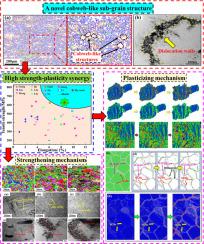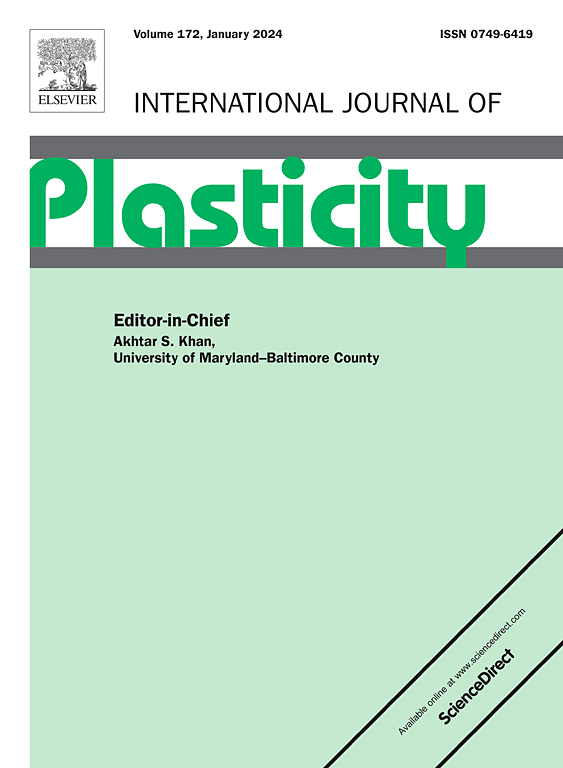具有高强度-塑性协同作用的新型蛛网状亚晶粒结构铝-铜-镁合金
IF 9.4
1区 材料科学
Q1 ENGINEERING, MECHANICAL
引用次数: 0
摘要
铝-铜-镁合金作为应用最广泛的轻质结构材料,已被公认为低碳经济交通领域的理想候选材料。然而,合金的抗拉强度和塑性无法同时提高,无法满足交通工具不断升级换代的要求。在这项研究中,受蛛网状结构的高抗拉强度和高塑性的启发,通过连续固溶、高应变速率轧制(4.4 s-1)、低温处理(-196°C)和时效处理(SRCA),在铝铜镁合金中形成了一种新型的蛛网状亚晶粒结构。值得注意的是,这种合金的抗拉强度和塑性均优于当前研究中报道的合金。在 SRCA 之后,获得了 206.2 Hv 和 619.6 MPa 的超高维氏硬度和抗拉强度值,比传统的 T6 热处理铝-铜-镁合金分别高出 39.8% 和 31.8%。同时,该合金的伸长率也从 4.31% 提高到 8.23%(提高了 90.9%)。更重要的是,高强度-塑性("双高")Al-Cu-Mg 合金归因于蛛网状亚晶粒结构,这是首次利用逆向思维提出的,通过提高位错来增强塑性,这是由于高应变速率轧制形成的高密度位错和低温处理产生的位错重排效应造成的。此外,还利用原位拉伸电子背散射衍射(EBSD)、分子动力学(MD)模拟和晶体塑性(CP)模型验证了强度-塑性机制。结果表明,类似于无数壁的蜘蛛网状亚晶粒结构形成了阻碍位错向高角度晶界(HAGB)迁移的屏障,并吸收了位错,从而减少了应力集中区的出现,即位错吸收和应力应变分担机制。此外,强化机制还与多尺度微结构的协同强化有关,包括微米级晶粒、微米级高密度位错晶格和纳米级 Al2CuMg 相,这些微结构在连续变形过程中被激活。因此,生物仿生结构设计的概念可作为实现高强度-塑性协同作用结构材料的有效方法,并可扩展到铁轨和车身结构设计等交通领域。本文章由计算机程序翻译,如有差异,请以英文原文为准。


A novel cobweb-like sub-grain structured Al-Cu-Mg alloy with high strength-plasticity synergy
Al-Cu-Mg alloys, as the most widely used lightweight structural materials, have been recognized as promising candidates in the transportation field for a low-carbon economy. However, the tensile strength and plasticity of alloys cannot be simultaneously improved to satisfy the requirements of continuously upgraded transportation vehicles. In this work, inspired by high-tensile strength and high plasticity of cobweb structure, a novel cobweb-like sub-grain structure was developed in Al-Cu-Mg alloys by a successive solution, high-strain-rate rolling (4.4 s-1), cryogenic treatment (–196 °C) and aging process (SRCA). Notably, the tensile strength and plasticity of this alloy were superior to those reported in the current study. An ultrahigh Vickers hardness and tensile strength value of 206.2 Hv and 619.6 MPa, which were 39.8 % and 31.8 % higher than those of traditional T6 heat-treated Al-Cu-Mg alloys, were obtained after SRCA. Meanwhile, an increase in the elongation of this alloy from 4.31 % to 8.23 % (increase of 90.9 %) was also achieved. More importantly, the high strength-plasticity (“double high”) Al-Cu-Mg alloy was attributed to a cobweb-like sub-grain structure, which was proposed for the first time by utilizing reverse thinking to enhance plasticity through elevating dislocations, due to the formation of high-density dislocations from high-strain-rate rolling and rearrangement effect of dislocations from cryogenic treatment. Furthermore, the strength-plasticity mechanism was verified using in-situ tensile electron back scatter diffraction (EBSD), molecular dynamics (MD) simulations, and crystal plasticity (CP) models. The results indicated that the cobweb-like sub-grain structure, resembling countless walls, formed barriers that hindered dislocation migration towards high-angle grain boundaries (HAGBs) and absorbed them, thereby reducing the occurrence of stress concentration zones, i.e., the dislocation absorption and stress-strain sharing mechanisms. Additionally, the strengthening mechanism was associated with synergistic strengthening by multiscale microstructures, including micron-sized grains, micron-sized high-density dislocation lattices, and nanosized Al2CuMg phases, which were activated by successive deformation processes. Consequently, the concept of biomimetic structure design, which may serve as an effective method for achieving structural materials with high strength-plasticity synergy, can be extended to transportation fields, such as railway tracks and body structure design.
求助全文
通过发布文献求助,成功后即可免费获取论文全文。
去求助
来源期刊

International Journal of Plasticity
工程技术-材料科学:综合
CiteScore
15.30
自引率
26.50%
发文量
256
审稿时长
46 days
期刊介绍:
International Journal of Plasticity aims to present original research encompassing all facets of plastic deformation, damage, and fracture behavior in both isotropic and anisotropic solids. This includes exploring the thermodynamics of plasticity and fracture, continuum theory, and macroscopic as well as microscopic phenomena.
Topics of interest span the plastic behavior of single crystals and polycrystalline metals, ceramics, rocks, soils, composites, nanocrystalline and microelectronics materials, shape memory alloys, ferroelectric ceramics, thin films, and polymers. Additionally, the journal covers plasticity aspects of failure and fracture mechanics. Contributions involving significant experimental, numerical, or theoretical advancements that enhance the understanding of the plastic behavior of solids are particularly valued. Papers addressing the modeling of finite nonlinear elastic deformation, bearing similarities to the modeling of plastic deformation, are also welcomed.
 求助内容:
求助内容: 应助结果提醒方式:
应助结果提醒方式:


